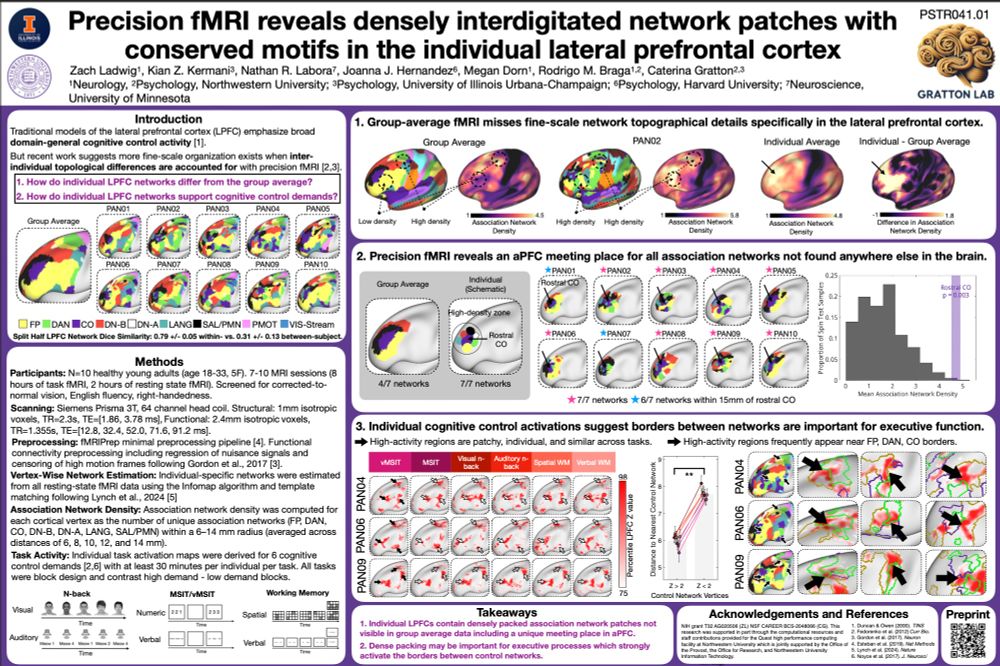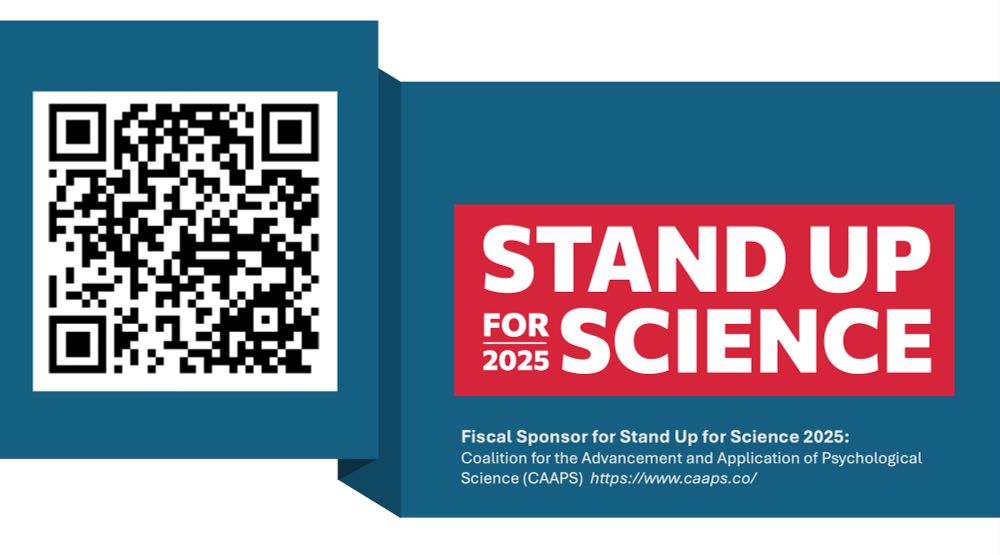
Poster from D. C. Perez entitled "increased inter-individual variability in functional network organization of older adults compared to younger adults"
3) @dianacperez.bsky.social is presenting TUESDAY AM at LPB028
Diana used precision datasets of younger and older adults to individual brain network maps
▶️ she shows that variability increases across the lifespan, suggesting new models for the development of individual differences
14.11.2025 15:56 — 👍 6 🔁 1 💬 0 📌 1

Image of Z. Ladwig poster entitled "Precision fMRI reveals densely interdigitated network patches with conserved motifs in the individual lateral prefrontal cortex"
1) @zachladwig.bsky.social will be available on SATURDAY PM at poster CC14
He’ll show his work using precision fMRI to identify new common network motifs in the PFC and investigate how network borders support executive function.
Preprint: www.biorxiv.org/content/10.1...
14.11.2025 15:56 — 👍 2 🔁 1 💬 1 📌 1
CATS Lab
Child & Adolescent Translational Science Lab at Northwestern University
I'm recruiting PhD students for my lab at Northwestern! I'm reviewing applications for the Department of Psychology for the Cognitive Affective Neuroscience and Clinical areas, due 12/1. 🧠
Come join the CATS Lab: nucatslab.com
Learn about our latest research: iamh.northwestern.edu/research/res...
29.10.2025 18:39 — 👍 55 🔁 44 💬 2 📌 1
Congrats @josephsalvo.bsky.social! 🧠🎓
Happy to have helped collect this dataset.
08.10.2025 15:16 — 👍 3 🔁 0 💬 0 📌 0

Our new paper is out now in Neuron! 🎉 With @vaibhavtripathi.bsky.social @maxwellelliott.bsky.social Joanna Ladopoulou, Wendy Sun, Mark Eldaief, and Randy Buckner
Paper link: www.sciencedirect.com/science/arti...
26.09.2025 15:24 — 👍 57 🔁 26 💬 2 📌 2

End of August means ECVP! This year, I am here (in beautiful Mainz) with a special mission - to find postdocs who will join us in (equally beautiful) Krakow, PL! Drop me a DM if you are interested!
@ecvp.bsky.social
25.08.2025 10:49 — 👍 8 🔁 5 💬 1 📌 1
Are there good neuro/neuroimaging journals that still accept brief communications, i.e., short papers focused on 1-2 results? Interesting results but not "major impact".
#neuroskyence
18.08.2025 14:40 — 👍 15 🔁 3 💬 1 📌 1
High frequency broadband activity detected noninvasively in infants distinguishes wake from sleep states https://www.biorxiv.org/content/10.1101/2025.08.08.668962v1
12.08.2025 15:15 — 👍 2 🔁 1 💬 0 📌 0
Overall, we found that noninvasive HFB detection is not only possible at sites where the skull hasn’t fully developed, but sufficiently robust to enable systematic investigation of early cognitive development!
Thanks to my co-authors, as well as to the Dynamic Brain Lab for their support! 🙂
12.08.2025 21:52 — 👍 0 🔁 0 💬 0 📌 0

Plot of how the reliability of the wake > sleep effect at the single-baby level relates to the number of trials used in analyses. Shading represents the standard error of the mean.
At the single-baby level, the same wake > sleep effects were detected with 60% reliability using as few as 50 seconds of data per state. Although this reliability is lower than the 90% group-level reliability, 60% is higher than reliabilities seen in other developmental scalp EEG studies.
12.08.2025 21:52 — 👍 1 🔁 0 💬 1 📌 0

Subject-by-trial reliability plots for midline (Fz, Cz, Pz), frontal (F3, F4), central (C3, C4), and occipital (O1, O2) channels. Darker red colors represent greater reliability (>50%), and darker grayscale colors represent lower reliability (<50%). White on the right portions of plots represents missing data resulting from channel exclusion within individual babies due to low data quality.
We found that when varying both the number of trials and babies included in group analyses, the reliability of the wake > sleep effect stabilized at ~90% at around 25 seconds of data per state, with as few as 10 babies (see panels A and C) and even fewer babies for occipital channels (see panel D)!
12.08.2025 21:52 — 👍 0 🔁 0 💬 1 📌 0

Topographic plots comparing HFB power between 25 seconds of wake data versus 25 seconds of sleep data per baby, across 18 babies. More red regions represent greater HFB power during wake states, and darker grayscale regions represent greater HFB power during sleep states. Significant channels are marked with larger black dots. There are 10 topographic plots because analyses were done 10 times for reliability analyses.
At the group level, we found that HFB power was greater in wake versus sleep states in midline and central channels near fontanelles, as well as occipital channels over thin skull. This was replicated 9/10 times (90% reliability) using as little as 25 seconds of data per state!
12.08.2025 21:52 — 👍 0 🔁 0 💬 1 📌 0
We analyzed scalp EEG data from 18 babies during wake and sleep states (5-second trials). Past intracranial work has shown that HFB is greater in wake vs. sleep states, so to see whether we could detect this signal in babies, we compared HFB power between these two states. 😴👶
12.08.2025 21:52 — 👍 0 🔁 0 💬 1 📌 0

Schematic of estimated fontanelle and suture locations (in pink), overlaid with scalp EEG channels arranged according to the international 10-20 system.
iEEG electrode implantation is extremely rare in babies because they have fontanelles (see pink regions in image) and thin skull. However, scalp EEG channels over these regions may be able to detect HFB since they are closer to brain tissue, allowing for less signal drop off!
12.08.2025 21:52 — 👍 0 🔁 0 💬 1 📌 0
HFB indexes local brain activity and is predominantly studied invasively using iEEG. This signal is tricky to detect with scalp EEG because it is attenuated as it passes through skull.
HFB has been studied across development, but to our knowledge, not in babies - why not?
12.08.2025 21:52 — 👍 0 🔁 0 💬 1 📌 0
I still get chills
Meet Mike
*30+ years severe depression
*first hospitalized @ 13y
*20 meds
*3 rounds of ECT
*2 near-fatal suicide attempts
Mike felt joy for the first time in decades after we turned on his new brain pacemaker or PACE
see videos, read paper, follow thread
doi.org/10.31234/osf...
10.08.2025 18:22 — 👍 390 🔁 137 💬 18 📌 35
Congrats @josephsalvo.bsky.social and @rementurus.bsky.social !
05.08.2025 16:50 — 👍 6 🔁 1 💬 0 📌 0
SO exciting to see the first results from this project, which we started when the lab first opened! Collecting this dataset was my main focus during my RCship, and we’re very grateful to the epilepsy patients who gave much of their time to make this happen. Congratulations, Chris! 🧠
05.08.2025 16:20 — 👍 4 🔁 0 💬 1 📌 0

Technical Associate I, Kanwisher Lab
MIT - Technical Associate I, Kanwisher Lab - Cambridge MA 02139
I’m hiring a full-time lab tech for two years starting May/June. Strong coding skills required, ML a plus. Our research on the human brain uses fMRI, ANNs, intracranial recording, and behavior. A great stepping stone to grad school. Apply here:
careers.peopleclick.com/careerscp/cl...
......
26.03.2025 15:09 — 👍 64 🔁 48 💬 5 📌 3
Congratulations Nate! BYU is lucky to have you. :)
04.03.2025 19:01 — 👍 1 🔁 0 💬 0 📌 0
Saxelab Social Cognitive Neuroscience Laboratory at MIT |
The Saxe Lab @ MIT is hiring! We seek one lab manager to start in summer 2025. Research in our lab focuses on social cognition (learn more on saxelab.mit.edu).
Please apply at: tinyurl.com/saxe2025 (Job ID 31993).
Review of applications starts on March 24, 2025.
Sharing appreciated. Thank you!
03.03.2025 18:32 — 👍 54 🔁 44 💬 2 📌 2
“Imagine publishing a preprint” :) Congrats @rementurus.bsky.social!
28.02.2025 17:34 — 👍 5 🔁 0 💬 0 📌 0

QR code and stand up for science logo, with paypal donation link: https://www.paypal.com/ncp/payment/9ZTLJN7MH6Z7E
📣 Want to DONATE to help us Stand Up for Science on March 7th? *NEW LINK!*
Make a tax-deductible donation using the QR code below!
Direct link: www.paypal.com/ncp/payment/...
#scienceforall #sciencenotsilence #standupforscience2025
26.02.2025 18:11 — 👍 76 🔁 52 💬 4 📌 12

Chicago, IL
Location: Federal Plaza 211 S Clark St, Chicago, IL, United States Address: 211 S Clark St, Chicago, IL 60604 Time: 12-3 PM
Hey #Chicago!
It's time to take a stand for #science. We are rallying on March 7 at noon at the Federal Plaza. Start making your signs!
Info
standupforscience2025.org/chicago-il/
RSVP (optional)
www.eventbrite.com/e/stand-up-f...
#standupforscience #scienceforall
@standupforscience.bsky.social
24.02.2025 03:09 — 👍 87 🔁 40 💬 1 📌 6

photo of illinois with text looking for illinois volunteers
☀️📣 Looking for a STATE LEAD and VOLUNTEERS to help us #standupforscience2025 in Illinois!
Know someone interested? Fill out this form: airtable.com/app4h5wUssMG...
#scienceforall #sciencenotsilence
20.02.2025 01:10 — 👍 19 🔁 16 💬 0 📌 1

Welcome to the Bluesky account for Stand Up for Science 2025!
Keep an eye on this space for updates, event information, and ways to get involved. We can't wait to see everyone #standupforscience2025 on March 7th, both in DC and locations nationwide!
#scienceforall #sciencenotsilence
12.02.2025 17:04 — 👍 11521 🔁 5461 💬 291 📌 674
Available Actions
If you are a neuroscientist, please use SFN's site to write to your reps about the importance of funding for science (they have letters ready to go, you can just use theirs or write/edit as you see fit): www.sfn.org/advocacy/adv...
07.02.2025 12:43 — 👍 48 🔁 31 💬 0 📌 3
Language processing - Neuroscience - Machine Learning - Assistant Professor at Stanford University - She/Her - 🏳️🌈
assistant professor of psychology at USC丨he/him丨semiprofessional dungeon master丨https://snastase.github.io/
Connecting scientists worldwide to advance research in developmental cognitive neuroscience.
NSF Postdoc Fellow at Princeton University | Incoming Assistant Professor of Psychology at Rutgers-Newark | studying how we regulate each others' emotions 👥 https://raziasahi.com/
she/her
PhD Student in Cognitive & Affective Neuroscience!🧠
Northwestern University nucatslab.com
meganspurney.com
Cognitive neuroscientist investigating the role of brain oscillations.
http://www.neuosc.com
Neuroscientist, educator, author of SO YOU WANT TO BE A NEUROSCIENTIST? (Columbia, 2020) & MIND OVER MATTER (Princeton TBD) // professor at ucsd // co-host of www.changetechnically.fyi with @grimalkina // www.ashleyjuavinett.com
Scientific journal publishing research, overview and commentary across all of biology. All of it!
https://www.cell.com/current-biology/home
Part of CellPress @cellpress.bsky.social
associate prof at university of minnesota | masonic institute for the developing brain | brain networks & behavior lab PI | views my own | oberlin to iu to penn to iu to umn | https://www.brainnetworkslab.com/
computational cog sci • problem solving and social cognition • asst prof at NYU • https://codec-lab.github.io/
Brain Stimulator | Associate Prof @StanfordMed | Co-founder @AltoNeuro | MD/PhD | My lab @StanfordPNTlab.bsky.social develops methods to modulate human brain circuits.
precisionneuro.stanford.edu
Cognitive neuroscientist at the University of Chicago. Curmudgeon. Posts are cosmic signals that penetrated my tin hat.
Assoc prof @UDelaware | social neuroscientist interested "us vs them" and "human vs AI" | Mexican, Indigenous, Japanese First Gen | #UDPBS | @UDPOSCIR | 🧠
https://www.ifsnlab.org/
Deconstructing brain stimulation tools to build personalized treatments for mental health disorders.
precisionneuro.stanford.edu
Postdoctoral researcher at the Center for Vital Longevity, UT Dallas, studying children's memory with intracranial EEG. My name is pronounced as 'Cheen'.
postdoc @stanfordpntlab.bsky.social | phd with @tobergmann.bsky.social | researching frontiers of neuromodulation & metaplasticity 🇵🇰🇩🇪🇺🇸
Neuroscience PhD student @ Stanford
Formerly Lab Manager @ Dynamic Brain Lab
B.S. @ UC San Diego
✨Precision Neurotherapeutics Lab |
CoPsyN Sleep Lab ✨
(she/her)
Cognitive neuroscientist | PI @ COGNIZELab | Prof @ ISTBI, Fudan, Shanghai | Exploring memory encoding, Default Mode Network and mental navigation with 7T fMRI @cognizelab.bsky.social
PhD in Psychology studying how loneliness affects the brain and health/ Head of the Social Neuroscience Lab, IoP PAS.
















